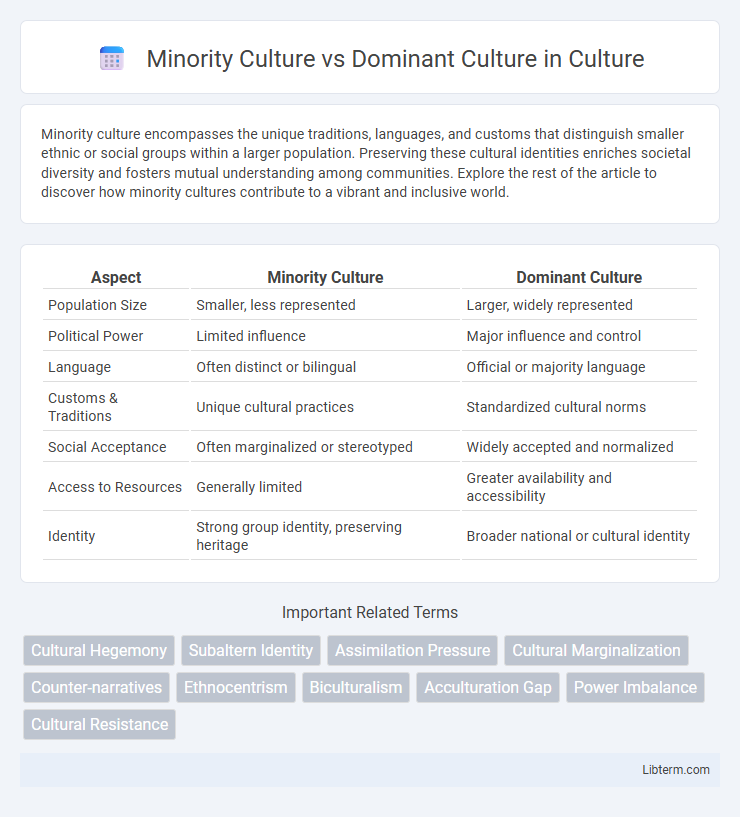Minority culture encompasses the unique traditions, languages, and customs that distinguish smaller ethnic or social groups within a larger population. Preserving these cultural identities enriches societal diversity and fosters mutual understanding among communities. Explore the rest of the article to discover how minority cultures contribute to a vibrant and inclusive world.
Table of Comparison
| Aspect | Minority Culture | Dominant Culture |
|---|---|---|
| Population Size | Smaller, less represented | Larger, widely represented |
| Political Power | Limited influence | Major influence and control |
| Language | Often distinct or bilingual | Official or majority language |
| Customs & Traditions | Unique cultural practices | Standardized cultural norms |
| Social Acceptance | Often marginalized or stereotyped | Widely accepted and normalized |
| Access to Resources | Generally limited | Greater availability and accessibility |
| Identity | Strong group identity, preserving heritage | Broader national or cultural identity |
Defining Minority and Dominant Cultures
Minority culture refers to groups differentiated by ethnicity, language, religion, or customs that exist within a larger society dominated by a different cultural norm. Dominant culture holds prevailing social, institutional, and political power, influencing mainstream values, practices, and language in a society. The distinction between minority and dominant cultures centers on power dynamics, cultural representation, and social influence rather than simply population size.
Historical Contexts of Cultural Dynamics
Historical contexts reveal how dominant cultures have often shaped societal norms, laws, and educational systems, marginalizing minority cultures by suppressing languages, traditions, and identities. Colonialism, migration, and state policies frequently established power imbalances that privileged dominant cultural narratives while delegitimizing minority cultural expressions. Resistance and adaptation by minority groups highlight ongoing cultural dynamics and struggles for recognition and equality within multicultural societies.
Power Structures and Cultural Influence
Power structures within dominant cultures often shape societal norms and control the dissemination of cultural narratives, marginalizing minority cultures and limiting their visibility. Minority cultures, despite facing systemic barriers, maintain distinct identities through resilient cultural practices and community networks that resist assimilation. Cultural influence flows predominantly from dominant to minority groups, impacting language, traditions, and social roles, while minority cultures contribute to cultural diversity and challenge hegemonic perspectives through acts of resistance and adaptation.
Identity Formation within Minority Groups
Minority culture plays a crucial role in identity formation by providing a sense of belonging, heritage, and shared values that contrast with the dominant culture's norms and expectations. Individuals within minority groups often navigate between cultural preservation and adaptation, leading to hybrid identities shaped by both their ethnic background and interactions with the dominant society. This dynamic fosters resilience and cultural pride, while also posing challenges related to social integration and self-perception.
Assimilation vs. Cultural Preservation
Assimilation often requires minority cultures to adopt the dominant culture's language, values, and behaviors, leading to the potential loss of unique cultural identities. Cultural preservation emphasizes maintaining traditional practices, languages, and customs to sustain cultural diversity amidst dominant societal pressures. The tension between assimilation and cultural preservation shapes social integration policies and impacts community resilience within multicultural societies.
Representation in Media and Popular Culture
Minority culture often faces underrepresentation and stereotypical portrayals in media and popular culture, limiting public understanding and perpetuating biases. Dominant culture controls the majority of media production, influencing which narratives are amplified and shaping societal norms. Increasing diverse representation challenges these imbalances, promoting inclusivity and authentic visibility for minority groups.
Language and Communication Barriers
Minority cultures often face significant language and communication barriers when interacting with dominant cultures, limiting access to education, healthcare, and social services. These barriers can result in misinterpretations, stereotyping, and exclusion within mainstream society. Effective cross-cultural communication strategies, including bilingual education and culturally sensitive translation services, are essential to bridge gaps and promote inclusivity.
Educational Inequities and Cultural Narratives
Educational inequities arise when dominant culture norms shape curricula and teaching methods, marginalizing minority cultures and limiting their academic success. Cultural narratives within dominant education systems often perpetuate stereotypes or omit minority perspectives, reinforcing systemic bias and exclusion. Addressing these disparities requires integrating diverse cultural content and inclusive pedagogies to create equitable learning environments.
Social Integration and Community Resilience
Minority cultures contribute unique perspectives and traditions that enhance social integration by promoting inclusivity and multicultural understanding within dominant cultures. Social integration efforts that respect and incorporate minority cultural identities strengthen community resilience by fostering mutual support networks and collective problem-solving. Collaborative initiatives between minority and dominant groups improve social cohesion, reduce marginalization, and build adaptive capacities in diverse communities.
Steps Toward Cultural Equity and Inclusion
Steps toward cultural equity and inclusion involve recognizing and validating the histories, values, and contributions of minority cultures within a society dominated by a prevailing culture. Implementing policies that promote equitable representation in education, media, and workplaces helps dismantle systemic barriers faced by marginalized groups. Empowering minority voices through inclusive decision-making processes enhances social cohesion and fosters mutual respect among diverse cultural communities.
Minority Culture Infographic

 libterm.com
libterm.com